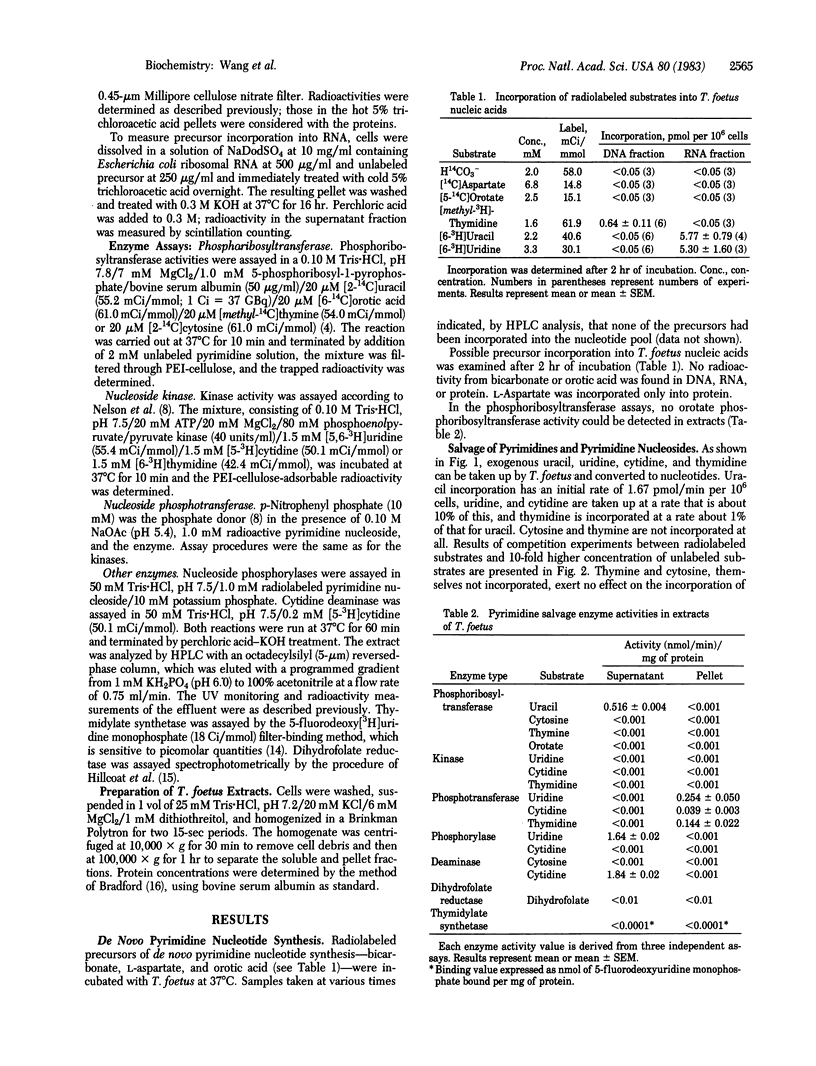Abstract
The anaerobic parasitic protozoa Tritrichomonas foetus is found incapable of de novo pyrimidine biosynthesis by its failure to incorporate bicarbonate, aspartate, or orotate into pyrimidine nucleotides or nucleic acids. Uracil phosphoribosyltransferase in the cytoplasm provides the major pyrimidine salvage for the parasite. Exogenous uridine and cytidine are mostly converted to uracil by uridine phosphorylase and cytidine deaminase in T. foetus prior to incorporation. T. foetus cannot incorporate labels from exogenous uracil or uridine into DNA; it has no detectable dihydrofolate reductase or thymidylate synthetase and is resistant to methotrexate, pyrimethamine, trimethoprim, and 5-bromovinyldeoxyuridine at millimolar concentrations. It has an enzyme thymidine phosphotransferase in cellular fraction pelleting at 100,000 X g that can convert exogenous thymidine to TMP via a phosphate donor such as p-nitrophenyl phosphate or nucleoside 5'-monophosphate. Thymidine salvage in T. foetus is thus totally dissociated from other pyrimidine salvage.
Full text
PDF




Selected References
These references are in PubMed. This may not be the complete list of references from this article.
- Bradford M. M. A rapid and sensitive method for the quantitation of microgram quantities of protein utilizing the principle of protein-dye binding. Anal Biochem. 1976 May 7;72:248–254. doi: 10.1006/abio.1976.9999. [DOI] [PubMed] [Google Scholar]
- Carson D. A., Chang K. P. Phosphorylation and anti-leishmanial activity of formycin B. Biochem Biophys Res Commun. 1981 Jun 16;100(3):1377–1383. doi: 10.1016/0006-291x(81)91976-8. [DOI] [PubMed] [Google Scholar]
- DIAMOND L. S. The establishment of various trichomonads of animals and man in axenic cultures. J Parasitol. 1957 Aug;43(4):488–490. [PubMed] [Google Scholar]
- Gutteridge W. E., Gaborak M. A re-examination of purine and pyrimidine synthesis in the three main forms of Trypanosoma cruzi. Int J Biochem. 1979;10(5):415–422. doi: 10.1016/0020-711x(79)90065-x. [DOI] [PubMed] [Google Scholar]
- Heyworth P. G., Gutteridge W. E., Ginger C. D. Purine metabolism in Trichomonas vaginalis. FEBS Lett. 1982 May 3;141(1):106–110. doi: 10.1016/0014-5793(82)80026-4. [DOI] [PubMed] [Google Scholar]
- Hill B., Kilsby J., Rogerson G. W., McIntosh R. T., Ginger C. D. The enzymes of pyrimidine biosynthesis in a range of parasitic protozoa and helminths. Mol Biochem Parasitol. 1981 Feb;2(3-4):123–134. doi: 10.1016/0166-6851(81)90094-3. [DOI] [PubMed] [Google Scholar]
- Hillcoat B. L., Nixon P. F., Blakley R. L. Effect of substrate decomposition on the spectrophotometric assay of dihydrofolate reductase. Anal Biochem. 1967 Nov;21(2):178–189. doi: 10.1016/0003-2697(67)90179-0. [DOI] [PubMed] [Google Scholar]
- Lindmark D. G., Jarroll E. L. Pyrimidine metabolism in Giardia lamblia trophozoites. Mol Biochem Parasitol. 1982 May;5(5):291–296. doi: 10.1016/0166-6851(82)90036-6. [DOI] [PubMed] [Google Scholar]
- Marr J. J., Berens R. L., Nelson D. J. Antitrypanosomal effect of allopurinol: conversion in vivo to aminopyrazolopyrimidine nucleotides by Trypanosoma curzi. Science. 1978 Sep 15;201(4360):1018–1020. doi: 10.1126/science.356267. [DOI] [PubMed] [Google Scholar]
- Marr J. J., Berens R. L., Nelson D. J., Krenitsky T. A., Spector T., LaFon S. W., Elion G. B. Antileishmanial action of 4-thiopyrazolo (3.4-d) pyrimidine and its ribonucleoside. Biological effects and metabolism. Biochem Pharmacol. 1982 Jan 15;31(2):143–148. doi: 10.1016/0006-2952(82)90203-9. [DOI] [PubMed] [Google Scholar]
- Marr J. J., Berens R. L., Nelson D. J. Purine metabolism in Leishmania donovani and Leishmania braziliensis. Biochim Biophys Acta. 1978 Dec 1;544(2):360–371. doi: 10.1016/0304-4165(78)90104-6. [DOI] [PubMed] [Google Scholar]
- McClard R. W., Black M. J., Livingstone L. R., Jones M. E. Isolation and initial characterization of the single polypeptide that synthesizes uridine 5'-monophosphate from orotate in Ehrlich ascites carcinoma. Purification by tandem affinity chromatography of uridine-5'-monophosphate synthase. Biochemistry. 1980 Sep 30;19(20):4699–4706. doi: 10.1021/bi00561a024. [DOI] [PubMed] [Google Scholar]
- Nelson D. J., LaFon S. W., Tuttle J. V., Miller W. H., Miller R. L., Krenitsky T. A., Elion G. B., Berens R. L., Marr J. J. Allopurinol ribonucleoside as an antileishmanial agent. Biological effects, metabolism, and enzymatic phosphorylation. J Biol Chem. 1979 Nov 25;254(22):11544–11549. [PubMed] [Google Scholar]
- Pfaller M. A., Marr J. J. Antileishmanial effect of allopurinol. Antimicrob Agents Chemother. 1974 May;5(5):469–472. doi: 10.1128/aac.5.5.469. [DOI] [PMC free article] [PubMed] [Google Scholar]
- Santi D. V., McHenry C. S. 5-Fluoro-2'-deoxyuridylate: covalent complex with thymidylate synthetase. Proc Natl Acad Sci U S A. 1972 Jul;69(7):1855–1857. doi: 10.1073/pnas.69.7.1855. [DOI] [PMC free article] [PubMed] [Google Scholar]
- Walsh C. J., Sherman I. W. Purine and pyrimidine synthesis by the avian malaria parasite, Plasmodium lophurae. J Protozool. 1968 Nov;15(4):763–770. doi: 10.1111/j.1550-7408.1968.tb02209.x. [DOI] [PubMed] [Google Scholar]
- Wang C. C., Simashkevich P. M. Purine metabolism in the protozoan parasite Eimeria tenella. Proc Natl Acad Sci U S A. 1981 Nov;78(11):6618–6622. doi: 10.1073/pnas.78.11.6618. [DOI] [PMC free article] [PubMed] [Google Scholar]


